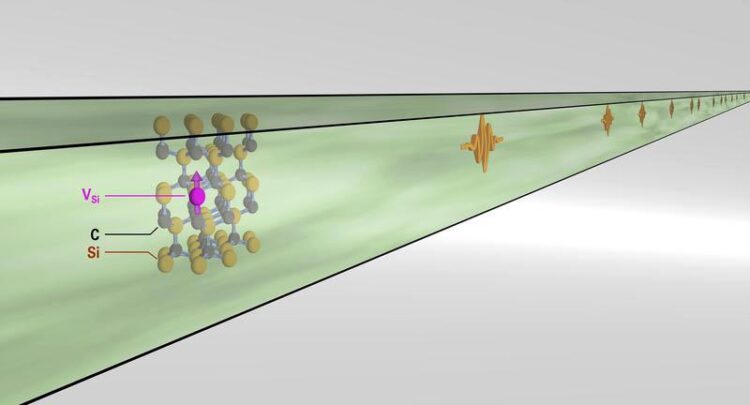Quantum computers getting connected

Visualisation of a VSi centre integrated into a nanophotonic SiC waveguide.
Credit: University of Stuttgart / Physics 3
Research team with participation of the University of Stuttgart succeeds in integrating color centers into nanophotonic silicon carbide structures.
A promising route towards larger quantum computers is to orchestrate multiple task-optimised smaller systems. To dynamically connect and entangle any two systems, photonic interference emerges as a powerful method, due to its compatibility with on-chip devices and long-distance propagation in quantum networks.
One of the main obstacles towards the commercialization of quantum photonics remains the nanoscale fabrication and integration of scalable quantum systems due to their notorious sensitivity to the smallest disturbances in the close environment. This has made it an extraordinary challenge to develop systems that can be used for quantum computing while simultaneously offering an efficient optical interface.
A recent result published in Nature Materials shows how the integration obstacle can be overcome. The work is based on a multi-national collaboration with researchers from Universities of Stuttgart (Physics 3), California – Davis, Linköping and Kyoto, as well as the Fraunhofer Institute at Erlangen, the Helmholtz Centre at Dresden and the Leibniz-Institute at Leipzig.
The researchers followed a two-step approach. First, their quantum system of choice is the so-called silicon vacancy centre in silicon carbide, which is known to possess particularly robust spin-optical properties. Second, they fabricated nanophotonic waveguides around these colour centres using gentle processing methods that keep the host material essentially free of damage.
“With our approach, we could demonstrate that the excellent spin-optical properties of our colour centres are maintained after nanophotonic integration.” says Florian Kaiser, Assistant Professor at the University of Stuttgart, the supervisor of this project. “Thanks to the robustness of our quantum devices, we gained enough headroom to perform quantum gates on multiple nuclear spin qubits. As these spins show very long coherence times, they are excellent for implementing small quantum computers.”
“In this project, we explored the peculiar triangular shape of photonic devices. While this geometry is of commercial appeal because it provides versatility needed for scalable production, little has been known about its utility for high performing quantum hardware. Our studies reveal that light emitted by the colour centre, which carries quantum information across the chip, can be efficiently propagated through a single optical mode. This is a key conclusion for viability of integration of colour centres with other photonic devices, such as nanocavities, optical fibre and single-photon detectors, needed to realize full functionalities of quantum networking and computing.” – says Marina Radulaski, Assistant Professor at the University of California – Davis.
What makes the silicon carbide platform particularly interesting are its CMOS compatibility and its heavy usage as high-power semiconductor in electric mobility. The researchers now want to benefit from these aspects to leverage the scalable production of spin-photonics chips. Additionally, they want to implement semiconductor circuitry to electrically initialise and readout the quantum states of their spin qubits. “Maximising electrical control – instead of traditional optical control via lasers – is an important step towards system simplification. The combination of efficient nanophotonics with electrical control will allow us to reliably integrate more quantum systems on one chip, which will result in significant performance gains.”, adds Florian Kaiser, “In this sense, we are only at the dawn of quantum technologies with colour centres in silicon carbide. Our successful nanophotonic integration is not only an exciting enabler for distributed quantum computing, but it can also boost the performance of compact quantum sensors.”
Journal: Nature Materials
DOI: 10.1038/s41563-021-01148-3
Method of Research: Experimental study
Subject of Research: Not applicable
Article Title: Fabrication and nanophotonic waveguide integration of silicon carbide colour centres with preserved spin-optical coherence
Article Publication Date: 18-Nov-2021
All latest news from the category: Information Technology
Here you can find a summary of innovations in the fields of information and data processing and up-to-date developments on IT equipment and hardware.
This area covers topics such as IT services, IT architectures, IT management and telecommunications.
Newest articles

Innovative 3D printed scaffolds offer new hope for bone healing
Researchers at the Institute for Bioengineering of Catalonia have developed novel 3D printed PLA-CaP scaffolds that promote blood vessel formation, ensuring better healing and regeneration of bone tissue. Bone is…

The surprising role of gut infection in Alzheimer’s disease
ASU- and Banner Alzheimer’s Institute-led study implicates link between a common virus and the disease, which travels from the gut to the brain and may be a target for antiviral…

Molecular gardening: New enzymes discovered for protein modification pruning
How deubiquitinases USP53 and USP54 cleave long polyubiquitin chains and how the former is linked to liver disease in children. Deubiquitinases (DUBs) are enzymes used by cells to trim protein…



